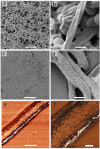2,4-Diacetylphloroglucinol Modulates Candida albicans Virulence
- PMID: 36294582
- PMCID: PMC9604888
- DOI: 10.3390/jof8101018
2,4-Diacetylphloroglucinol Modulates Candida albicans Virulence
Abstract
The dimorphic fungus Candida albicans is one of the most important opportunistic pathogens for humankind. The use of fungicides against Candida could be associated with sub-inhibitory effects, which are referred to as fungal stress responses and are undesirable for the host. In this work, we investigated the antifungal action of 2,4-diacetylphloroglucinol (2,4-DAPG) against Candida albicans ATCC 10231 with a focus on their biofilm-forming ability. We found that 2,4-DAPG was able to reduce the ability of Candida cells to form biofilms, but complete inhibition and eradication effects were not achieved. Furthermore, C. albicans cells in the adherent state were characterized by reduced susceptibility to 2,4-DAPG compared to planktonic cells. The investigation of the mechanisms that could explain the antibiofilm action of 2,4-DAPG revealed a reduction in the cell`s surface hydrophobicity and the inhibition of the yeast-to-hyphae transition. The inhibition of the Candida cells filamentation was accompanied by an increase in the expression of the NRG1 gene, which is a negative regulator of hyphal development. In addition, we microscopically visualized the treated biofilms and revealed numerous channels that were decorated with particles and localized on the hyphae. We assumed that these hyphal structures could be associated with the secretion of aspartyl proteases (Sap). The performed assessments revealed an increase in the activity of Sap, which was accompanied by an increase in the expression of the sap2 and sap4 genes. The antifungal action of 2,4-DAPG is known to be associated with affecting the permeability of cellular structures, which leads to H+ATPase malfunction and the disruption of mitochondrial respiration. The subsequent cytosol acidification and generation of ROS trigger the inhibition of Candida filamentation and activation of Sap production. The introduction of antioxidant Trolox simultaneously with 2,4-DAPG leads to a reduction in Sap production. Collectively, the obtained data indicate new aspects of the interaction of fungal cells with 2,4-DAPG, an antimicrobial metabolite of Pseudomonas spp.
Keywords: 2,4-diacetylphloroglucinol; Candida albicans; aspartyl protease; biofilm; hyphal channels; virulence.
Conflict of interest statement
The authors declare no conflicts of interest.
Figures








Similar articles
-
Proteomic analysis uncovers the modulation of ergosterol, sphingolipid and oxidative stress pathway by myristic acid impeding biofilm and virulence in Candida albicans.J Proteomics. 2019 Sep 30;208:103503. doi: 10.1016/j.jprot.2019.103503. Epub 2019 Aug 24. J Proteomics. 2019. PMID: 31454558
-
Candida albicans hyphal formation and the expression of the Efg1-regulated proteinases Sap4 to Sap6 are required for the invasion of parenchymal organs.Infect Immun. 2002 Jul;70(7):3689-700. doi: 10.1128/IAI.70.7.3689-3700.2002. Infect Immun. 2002. PMID: 12065511 Free PMC article.
-
A curcumin-sophorolipid nanocomplex inhibits Candida albicans filamentation and biofilm development.Colloids Surf B Biointerfaces. 2021 Apr;200:111617. doi: 10.1016/j.colsurfb.2021.111617. Epub 2021 Feb 6. Colloids Surf B Biointerfaces. 2021. PMID: 33592455
-
Suppression of hyphal formation and virulence of Candida albicans by natural and synthetic compounds.Biofouling. 2021 Jul;37(6):626-655. doi: 10.1080/08927014.2021.1948538. Epub 2021 Jul 20. Biofouling. 2021. PMID: 34284656 Review.
-
Hyphal development in Candida albicans from different cell states.Curr Genet. 2018 Dec;64(6):1239-1243. doi: 10.1007/s00294-018-0845-5. Epub 2018 May 23. Curr Genet. 2018. PMID: 29796903 Review.
Cited by
-
Lipase-Responsive Amphotericin B Loaded PCL Nanoparticles for Antifungal Therapies.Nanomaterials (Basel). 2022 Dec 29;13(1):155. doi: 10.3390/nano13010155. Nanomaterials (Basel). 2022. PMID: 36616065 Free PMC article.
-
Antifungal Effects of the Phloroglucinol Derivative DPPG Against Pathogenic Aspergillus fumigatus.Antibiotics (Basel). 2025 May 13;14(5):499. doi: 10.3390/antibiotics14050499. Antibiotics (Basel). 2025. PMID: 40426565 Free PMC article.
-
Deciphering the role of rhizosphere microbiota in modulating disease resistance in cabbage varieties.Microbiome. 2024 Aug 30;12(1):160. doi: 10.1186/s40168-024-01883-0. Microbiome. 2024. PMID: 39215347 Free PMC article.
-
A review on mechanisms and prospects of endophytic bacteria in biocontrol of plant pathogenic fungi and their plant growth-promoting activities.Heliyon. 2024 May 23;10(11):e31573. doi: 10.1016/j.heliyon.2024.e31573. eCollection 2024 Jun 15. Heliyon. 2024. PMID: 38841467 Free PMC article. Review.
-
Mar1, a high mobility group box protein, regulates n-alkane adsorption and cell morphology of the dimorphic yeast Yarrowia lipolytica.Appl Environ Microbiol. 2024 Aug 21;90(8):e0054624. doi: 10.1128/aem.00546-24. Epub 2024 Jul 26. Appl Environ Microbiol. 2024. PMID: 39058021 Free PMC article.
References
-
- Keel C., Weller D.M., Natsch A., Défago G., Cook R.J., Thomashow L.S. Conservation of the 2,4-diacetylphloroglucinol biosynthesis locus among fluorescent Pseudomonas strains from diverse geographic locations. Appl. Environ. Microbiol. 1996;62:552–563. doi: 10.1128/aem.62.2.552-563.1996. - DOI - PMC - PubMed
-
- Troppens D., Moynihan J., Barret M., O’Gara F., Morrissey J. Genetics and Evolution of 2,4-Diacetylphloroglucinol Synthesis in Pseudomonas fluorescens. In: Bruijn F.J., editor. Molecular Microbial Ecology of the Rhizosphere. John Wiley & Sons; Hoboken, NJ, USA: 2013. pp. 593–605.
-
- Kwak Y.S., Han S., Thomashow L.S., Rice J.T., Paulitz T.C., Kim D., Weller D.M. Saccharomyces cerevisiae genome-wide mutant screen for sensitivity to 2,4-diacetylphloroglucinol, an antibiotic produced by Pseudomonas fluorescens. Appl. Environ. Microbiol. 2011;77:1770–1776. doi: 10.1128/AEM.02151-10. - DOI - PMC - PubMed
-
- Troppens D., Dmitriev R., Papkovsky D., O’Gara F., Morrissey J. Genome-wide investigation of cellular targets and mode of action of the antifungal bacterial metabolite 2,4-diacetylphloroglucinol in Saccharomyces cerevisiae. FEMS Yeast Res. 2013;13:322–334. doi: 10.1111/1567-1364.12037. - DOI - PubMed
Grants and funding
LinkOut - more resources
Full Text Sources
Miscellaneous

